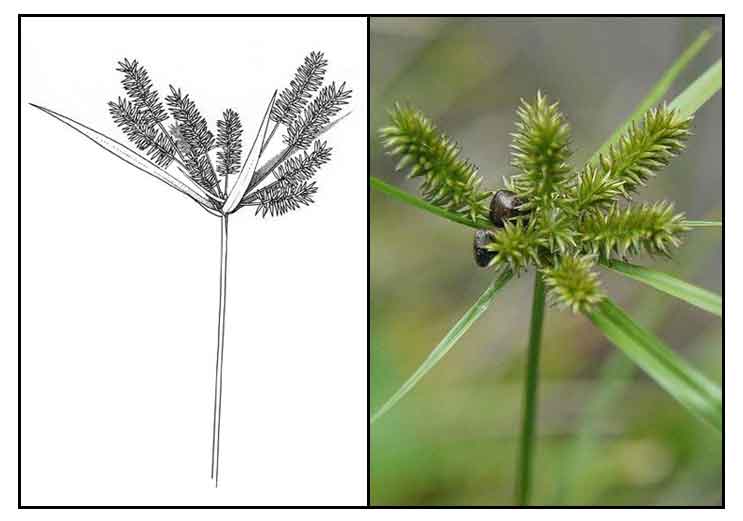
Family • Cyperaceae
Mañgilang
Cyperus cyperoides (L.) Kuntze
TALL SEDGE / PACIFIC ISLAND FLAT SEDGE
Zhuan zi miao
| Scientific names | Common names |
| Cyperus biglumis C.B.Clarke | Kupiupi (Sub.) |
| Cyperus cylindrostachys var. subcompossitus (C.B.Clarke) Skottsb. | Mañgilang (Sub.) |
| Cyperus cyperoides (L.) Kuntze. . . . | Muta (Pamp.) |
| Cyperus flexifolius Boeckeler ex Reinecke | Okokiang (Bon.) |
| Cyperus konkanensis T.Cooke | Cat grass (Engl.) |
| Cyperus linctus G.Forst. | Flat sedge (Engl.) |
| Cyperus macrocarpus var. humbertii (Cherm.) Kük | Pacific Island flat sedge (Engl.) |
| Cyperus macrocarpus var. submacrocarpus Kük | Tall sedge (Engl.) |
| Cyperus manilensis Boeckeler ex Warb. | |
| Cyperus sieberianus (Nees ex Steud.) K. Schum. | |
| Cyperus steudelianus Boeckleler | |
| Cyperus subumbellatus Kük | |
| Cyperus subumbellatus var. sessilispicatus Kük | |
| Cyperus subumbellatus var. subglobosus Kük | |
| Cyperus umbellatus Roxb. | |
| Cyperus umbellatus (Rottb.) Benth. | |
| Kyllinga biglumis (Gaertn.) Steud. | |
| Kyllinga sumatransis Retz. | |
| Kyllinga umbellata Rottb. . . . . | |
| Lipocarpha mangarevica H.St.John | |
| Mariscus alternifolius Vahl. | |
| Mariscus biglumis Gaertn. | |
| Mariscus clarkei Turrill ex Craib | |
| Mariscus concinnus Schrad. ex Nees . . . | |
| Mariscus corymbosus Boeckeler | |
| Mariscus cyperoides (L.) Urb. . . . | |
| Mariscus humbertii Cherm. | |
| Mariscus linctus M.R.Almeida . . . | |
| Mariscus nossibeensis Steud. | |
| Mariscus pachystachyus Steud. | |
| Mariscus philippensis Steud. | |
| Mariscus polyphyllus Steud. | |
| Mariscus quarrei Cherm. | |
| Mariscus sieberianus Nees ex Steud. . . . | |
| Mariscus steudelianus (Boeckeler) Cufod. | |
| Mariscus sumatrensis (Retz.) J. Raynal . . . | |
| Mariscus umbellatus J.Presl & C.Presl . . . | |
| Mariscus umbellatus Vahl. | |
| Scirpus cyperoides L. | |
| Cyperus cyperoides (L.) Kuntze is an accepted species. (It has 67 synonyms.) KEW: Plants of the World Online | |
| Other vernacular names |
| CHINESE: Zhuan zi miao. |
| INDIA: Kolpullu (Malayalam). |
| INDONESIA: jukut bebalean (Sundanese), suket lumbungan (Javanese), tetemung (southern Sumatra). |
| JAPANESE: Inu kugu. |
| KOREAN: Bang dong sa ni a jae bi. |
| MALAYSIA: menderong ekur tupai, rumput janggut baung, rumput mesiyang (Peninsular). |
| PAPUA NEW GUINEA: kaiga (Ialibu, Southern Highlands) |
| SWEDEN: Liten parasollsäv. |
| THAILAND: yaa rang-kaa (Loei). |
Gen info Botany
Distribution Constituents Properties Studies Availability |
Updated June 2024 / Dec 2019 / Aug 2016
![]()
 |
PHOTOS / ILLUSTRATIONS |
| IMAGE SOURCE: Illustration: Line drawing / Cyperus cyperoides / Manual of the Alien Plants of Belgium / Click on image to go to souce page / Allen Plants Belgium |
| OTHER IMAGE SOURCE: / Photo: File:Cypress cyperoides inukugu02.jpg / Keisotyo / 2008,10.25;Tanabe City, Wakayama prefecture, Japan /GNU Free Documentation License / Public Domain / Wikimedia Commons |
| IMAGE SOURCE: Cyperaceae : Cyperus cyperoides / Inflorescence / Copyright © 2011 by Leonardo L Co [ref. DOL30020] / Non-Commercial Use / Image modified / Click on image or link to go to source page / Phytoimages.siu.edu |
Additional
Sources and Suggested Readings |
뱥(5) |
DOI: It is not uncommon for links on studies/sources to change. Copying and pasting the information on the search window or using the DOI (if available) will often redirect to the new link page. (Citing and Using a (DOI) Digital Object Identifier) |
| Â Â Â Â Â Â Â Â Â Â Â Â Â Â Â Â Â Â Â Â Â Â Â Â Â Â Â Â Â Â List of Understudied Philippine Medicinal Plants |
| Â Â Â Â Â Â Â Â Â Â Â Â Â Â Â Â Â Â Â Â Â New plant names needed The compilation now numbers over 1,300 medicinal plants. While I believe there are hundreds more that can be added to the collection, they are becoming more difficult to find. If you have a plant to suggest for inclusion, native or introduced, please email the info: scientific name (most helpful), local plant name (if known), any known folkloric medicinal use, and, if possible, a photo. Your help will be greatly appreciated. |
뱥(5) |
 |
• |



